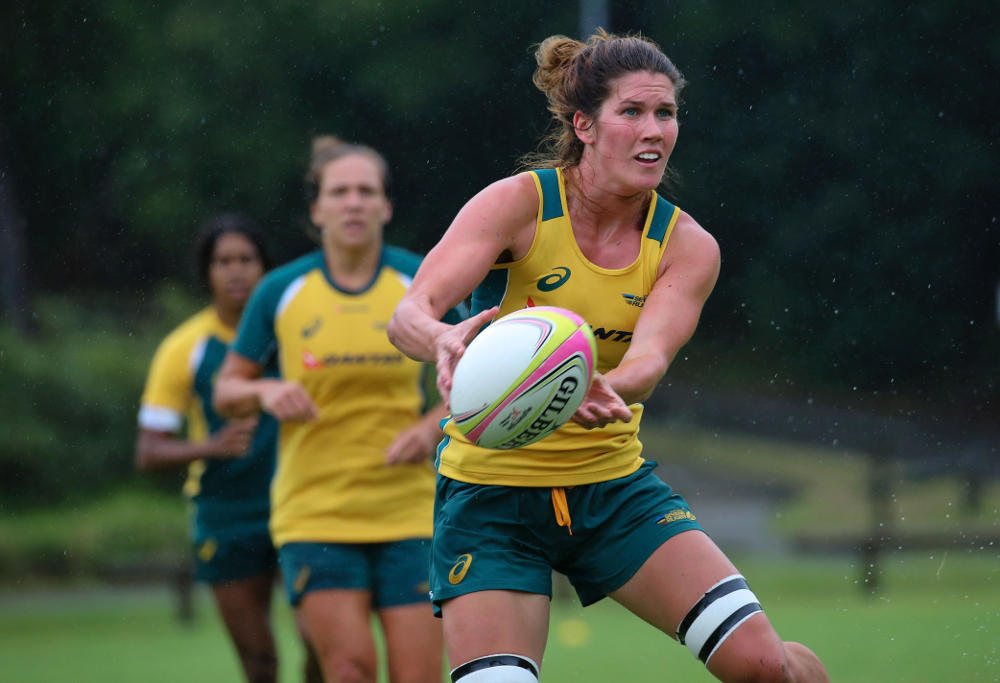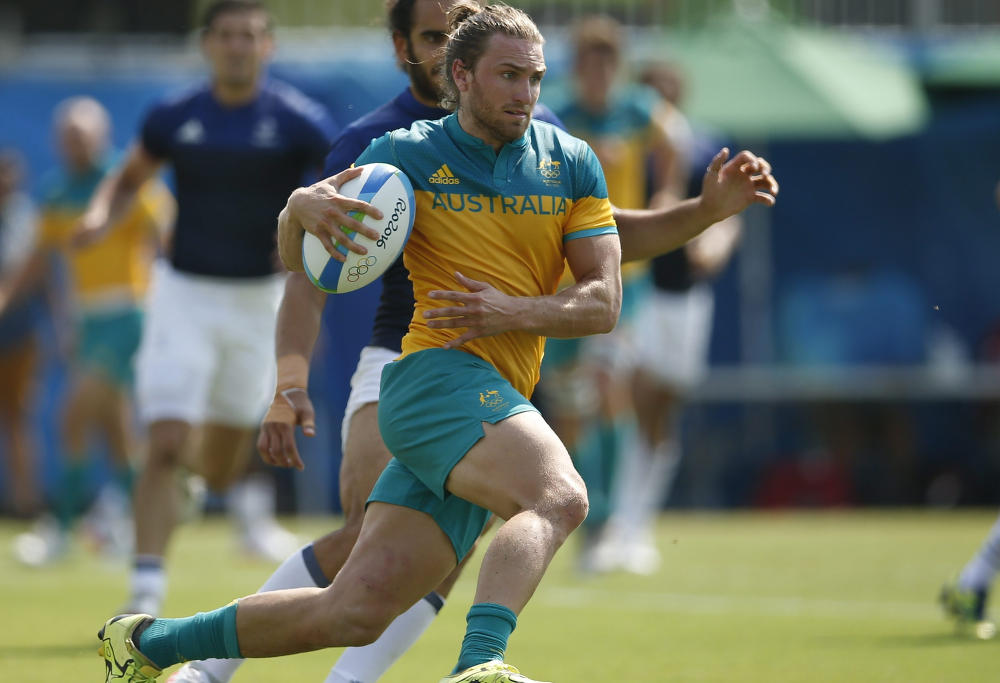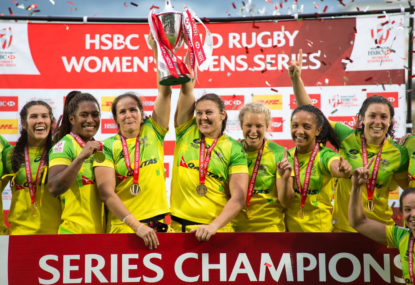It’s a pity that the Australian women’s (especially) and men’s sevens teams bowed out before the grand finals of the Sydney Sevens.
In its totality, though, on and off the field, the Sydney Sevens was a super success here in Australia and around the world.
There were great crowds and a celebration of a form of rugby and its inclusive qualities that enthused diehard spectators, including thousands at the stadium and those watching around the world on their television sets.
The tournament was televised in 100 countries and the entertainment and the spectacle offered deserved this sort of world-wide attention. As a sign of how popular around the world the World Rugby Sevens series has become, the next tournament in Vancouver is already a sell-out.
There is a challenge here for the ARU capitalise on this exploding popularity for sevens rugby. The task should be to make sevens rugby the rugby equivalent of cricket’s Big Bash in Australia.
It is in the process of doing this, admittedly. But mainly for women’s sevens.

Last week the ARU announced a comprehensive plan to grow the women’s sevens rugby game. The insurance giant AON will give financial support for the Pearls and for development programs from schoolgirl sevens through to the international level. This program includes a new women’s sevens competition involving eight universities from all the states, including Tasmania.
This is terrific but what about men’s sevens?
The Australian men’s sevens side, the Thunderbolts – who did so well in Sydney and exceeded expectations after their dismal performances at Wellington – had a number of players 21 years and under. These players came from the heartland clubs.
This fact should be an urgent reminder to the chief executive of the ARU, Bill Pulver, that these clubs need much more support from the ARU than they get now.
Tim Anstee, who on Saturday scored one of the quickest hat tricks in history in a must-win match against Scotland and then a sensational try early on in the semi-final against South Africa, played second-grade colts for the Sydney heartland club Eastwood last year.
Pulver, however, seems to believe that a tremendous amount of the resources of the ARU must go into women’s rugby and much less money should be allocated to the men’s game at the school and clubs levels.
He doesn’t seem to understand the men’s game that provides the players and money (for the ARU to spend) is dependent in many ways on the neglected heartland schools and clubs. Where does Pulver think players like Tim Anstee and others young stars like harry Hutchinson (a Randwick club youngster) are going to come from?

Surely, the ARU should embrace the fact that both the women’s and men’s sevens rugby programs need proper financing and organisation?
Why not set up a total sevens rugby program that aligns a men’s program going from the schools to the international level – along with the women’s sevens program?
I watched the Sydney Sevens while flicking back and forth on my television set with the Auckland Nines.
Warning! League fundamentalists need to stop reading at this point and drop down several paragraphs to prevent heart attacks while I discuss (very briefly) the Auckland Nines, the Brisbane Tens and the Sydney Sevens.

What struck me about the Auckland Nines is how similar the game with nine players plays out with the 13-a-side game.
There are significantly shorter halves and only four play-the-balls rather than six. But for all practical and viewing purposes, nines league is the same game as 13-a-side league. It is not an essentially different game and viewing experience the way sevens rugby is from the 15-a-side (and ten-a-side) game.
Remember the great thinker about league, Warren Ryan, has argued for decades that league should become an 11-a-side game. Nines league essentially reflects this Ryan doctrine.
Just to show that I am even-handed about all this theorising, I would apply the same argument to the rugby tens concept that is coming up at Brisbane’s Suncorp Stadium shortly.
All the rugby tens games I have seen, and I am sure the Brisbane tournament will prove no different, suggest to me that this form of the game is merely traditional rugby writ smaller.
It is not a different game from the traditional 15-a-side game that rugby sevens is.
Rugby sevens has, by definition, less than half the number of players on the field than 15s rugby. This means, in turn, that the set piece is much less prominent as a tactical weapon in sevens rugby than it is in traditional 15-a-side rugby.
Sevens rugby, too, has one of the essential elements of rugby league embedded in it, namely that the set piece is essentially a way of starting play. The lineouts (to a certain extent) and the scrums (also to a certain extent) are less an end in themselves in sevens rugby than they are in 15s rugby.
I qualified this by noting “to a certain extent” because some teams lost a couple of lineouts and the All Blacks sevens side got a crucial turnover in their quarter-final against Fiji by shoving them off the ball at a scrum.
It was noticeable, however, that even experienced referees like Craig Joubert (the boss of the sevens rugby referees and obviously the standard-setter) allowed rugby league-type scrum feeds where the ball barely touched the feet of the front row on its diagonal feed through to the back. Crooked lineout throws, too, were given a “play on” ruling.
The point about all this is that the ball is in play for long periods of time in sevens rugby and with only sevens defenders there is enormous pressure on the aerobic fitness of the players and their accuracy in making their tackles.
We got a fascinating insight into just how physically demanding sevens rugby is from the New England Patriots safety Nate Ebner talking about his experience of playing for the United States men’s sevens side at the Rio Olympics: “It’s like soccer on steroids with tackling and wrestling. In terms of cardiovascular endurance for sevens was one of the most challenging things I have ever put myself through in my life.
“Football (American football) is definitely challenging physically – but not like sevens. The mental toughness to push through that … That’s the different level of things right there.”
The further point from this, and we saw it time and time again in the Sydney Sevens, is that if a team could retain possession either with terrific ensemble play and/or a flow of penalties running its way, it could build up such a tidal wave of momentum that even the best teams like the Australian women’s sevens side or the New Zealand women’s sevens side could be overwhelmed by sides they regularly defeat.
Both these teams were bundled out of the finals when they failed to cope with and turn back the momentum of play running against them.
It is this rush of momentum changing expected outcomes that makes sevens rugby, like Big Bash cricket, so enthralling.
The unpredictability of results gives an edge to every game. This factor, in turn, gives an excitement and an edge to all the games, especially when the home side was playing. 75,000 spectators watched the 40 games of the Sydney Sevens over three days of intense heat, a tribute to the spectacle offered by all the teams.
I felt the Pearls went into the Sydney Sevens tournament with the wrong psychological frame of mind. For several days before the tournament, the team talked about how there was “more pressure” on them playing in Sydney than there was even playing at the Rio Olympics.
Coach Tim Walsh conceded that the Pearls loss to Canada in the semi-finals was “devastating” and that the pressure of playing at home “got to” the players.
Well, he allowed the players to explain to the journalists how they felt the weight of home pressure. Walsh should have stopped this talk which always had the potential to de-rail the Pearls.
The All Blacks showed how home pressure can be turned to a team’s advantage during the Rugby World Cup 2011 tournament by creating the vibe of the players embracing this pressure, enjoying it and taking strength from the fact that the nation was behind them in their quest for victory.
The Pearls should have been schooled to enjoy the pressure of being home favourites rather than feeling oppressed by it.

In big sport, the important victories are won in the mind before they are achieved on the playing field.
The Thunderbolts, on the other hand, seemed to rise to the occasion with the support of the home crowd inspiring them to a series of splendid, if unexpected, victories.
Andy Friend, the coach of the thunderbolts, did a terrific job with his selections for the tournament and the bold, aggressive style he coached the team to play.
His thoughts about Tim Anstee and the band of youngsters he selected for this home tournament for the Thuderbolts should be listened to by Michael Cheika: “It’s massive for him and it’s massive for the other boys … So everyone goes, ‘If Tim Anstee can do it, I can do it’ … it gives all the others the massive belief.”
At half-time in the semi-final against the wonderful South African men’s sevens side (surely a blueprint for the way the Springboks should play?), Friend told his players to run directly at the South Africans the way Anstee did: “If they come at you, run at them like Timmy, run hard.”
Michael Cheika gave out the jerseys to the Thunderbolts before the tournament started. Apparently, he made a passionate speech about how they could rise to the occasion and do their jersey proud.
There is a lesson here for Michael Cheika. Andy Friend gave a group of young players a chance and they delivered the goods for him. How about Cheika doing the same sort of thing with the Wallabies?

































































































